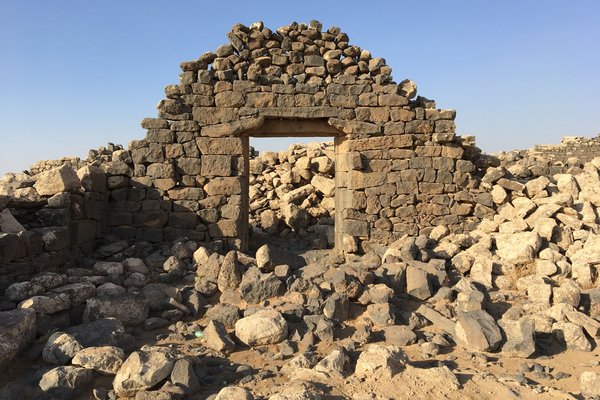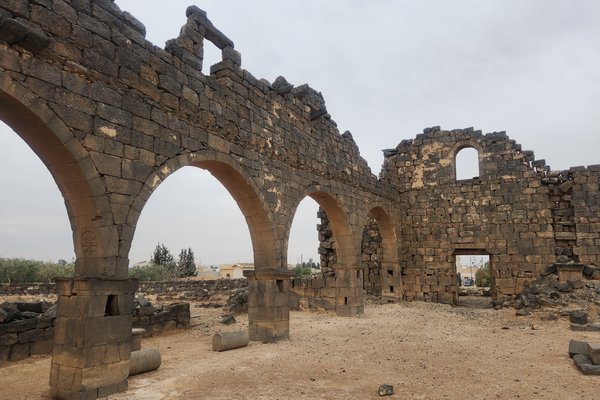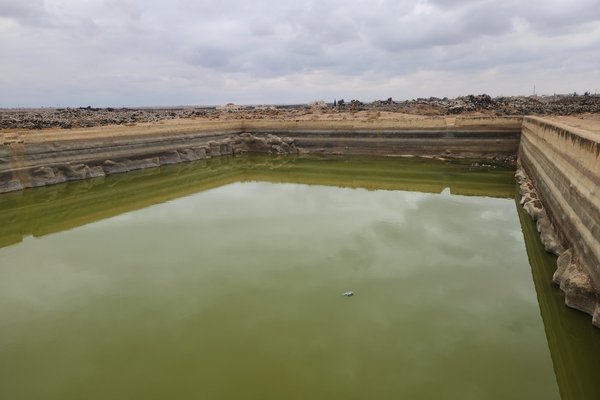Jordan
Umm Al-Jimāl
Umm Al-Jimāl comprises the well-preserved remains of a rural settlement on the Hauran plateau dating back to the 5th-8th century.
Its non-monumental architecture evolved organically, with the construction of churches and houses in a distinct local basaltic style and the reuse of buildings left by the Ancient Romans. Its buildings' pragmatic and durable character reflects the agro-pastoral lifestyle of the people who lived in this arid region that spans parts of southern Syria and northern Jordan.
Community Perspective: Wojciech visited in 2017 and found a huge site that takes 2-3 hours to explore. Despite its proximity to the Syrian border, Philipp found it easy to reach by rental car, and he enjoyed the black basalt building material the most. Els has provided public transport access info.
Site Info
Official Information
- Full Name
- Umm Al-Jimāl (ID: 1721)
- Country
- Jordan
- Status
-
Inscribed 2024
Site history
History of Umm Al-Jimāl
- 2024: Inscribed
- Inscribed
- 2018: Revision
- Successor to Um el-Jimal (City) (2001-2018)
- Type
- Cultural
- Criteria
- iii
Links
- UNESCO
- whc.unesco.org
- Official
-
- ummeljimal.org — Umm el-Jimal Project
All Links
UNESCO.org
- whc.unesco.org — whc.unesco.org/
Official Website
- ummeljimal.org — Umm el-Jimal Project
News Article
- Nov. 7, 2024 jordantimes.com — Jordan Hejaz Railway Corporation launches first tourist trip to 'UNESCO-listed' Umm Jimal
Community Information
- Community Category
- Archaeological site: Near Eastern
Travel Information
Recent Connections
-
Perfect Inscriptions
2024 -
Irrigation and drainage
"The town formed part of a broader agri… -
Horse Stables
"Rooms surrounded all or some sides of …
Connections of Umm Al-Jimāl
- Individual People
-
-
Lawrence of Arabia
T. E. Lawrence wrote of "ruined Um el Jemal", "There seemed evidence of bluntness of mind in these Roman frontier cities, Um el Jemal, Um el Surab, Umtaiye. Such incongruous buildings, in what was then and now a desert cockpit, accused their builders of insensitiveness; almost of a vulgar assertion of man's right (Roman right) to live unchanged in all his estate."(wiki)See en.wikipedia.org
-
- Trivia
-
-
Dubbed as another WHS
Black Petra
-
- History
-
-
Byzantine Empire and Civilization
"Umm Al-Jimal bears testimony to the rural way of life on the Hauran plateau in the Byzantine and Early Islamic periods, and epitomises the Hauranian culture with its agro-pastoral identity, reflecting the social values and cultural traditions of the Hauranian people. It provides a window into the hinterland of the imperial capitals and urban centres of the time." - AB Evaluation -
Nabatean culture
"The extent of these earliest Nabataean and Roman settlements cannot be confirmed as the village and the town were destroyed in the 3rd century CE, and the building material was used in later constructions." (AB ev)
-
- Architecture
-
-
Restored by anastylosis
"Some of the structures have been propped or consolidated, others were dismantled after being thoroughly documented and rebuilt as per original (anastylosis of the cathedral completed in 2016)." (AB Ev) -
Spolia
"The extent of these earliest Nabataean and Roman settlements cannot be confirmed as the village and the town were destroyed in the 3rd century CE, and the building material was used in later constructions." (AB ev) -
Mosaic art
"Several of Umm el-Jimal's churches are home to mosaics depicting animals, plants, and geometric patterns. These ancient mosaics are most likely influenced by the school at Madaba, which in antiquity was a famous center for mosaic art and production. Often incredibly fragile, Umm el-Jimal's remaining mosaics are a prime concern for the site's long-term conservation efforts." - (Umm el-Jimal Project) -
Made out of basaltic material
"embodied in the well-preserved distinctive basalt architecture" (OUV)
-
- Damaged
-
-
Destroyed or damaged by Earthquake
"Around this time the population decreased, especially after an earthquake hit Umm el-Jimal in A.D. 749. The site was gradually abandoned during the 9th century, in the Abbasid era. The actual cause of that abandonment is best seen as a combination of events – the aftermath of earthquake, rolling pandemic, drought and shift of political epicenter to Baghdad." - (Umm el-Jimal Project)
-
- World Heritage Process
-
-
Perfect Inscriptions
2024 -
2 or more nominated criteria rejected by AB
4 and 5 rejected -
Inscribed on a single criterion only
Crit iii
-
- Religion and Belief
-
-
Converted Mosques
"There is also a possibility that at least one of the churches was converted into a mosque after the Islamic conquest." (AB Ev) -
Mentioned in the Bible
The Roman predecessor of the inscribed settlement "could be ancient Roman Thantia and biblical Beth Gamul (Jeremiah 48:23)".See vici.org
-
- Human Activity
-
-
Multilingual inscriptions
"A rich epigraphic corpus in Greek, Nabataean, Safaitic, Latin and Arabic uncovered on the site and spanning many centuries provides insights into the history and functioning of Umm Al-Jimal, and sheds light on the changes in the religious beliefs of its inhabitants. The inscriptions are displayed at the Inscription Garden adjacent to the Interpretive and Hospitality Centre, located within the area of the nominated property." (AB Ev) -
Irrigation and drainage
"The town formed part of a broader agricultural landscape that included a complex water catchment system ensuring irrigation of the fields. It has been in operation from the Nabataean period onwards, and is still used today. It included a network of channels connecting the settlement to the nearby wadi, and at least twenty-six reservoirs located in the town and four in the village. The water system was based on a local concept and designed to ensure sustainable use of scarce water resources." "The water catchment system was revitalised in 2016-2017 and reactivated in 2019-2021, with a modern delivery system added." (AB Ev) -
Irrigation and drainage
"The town formed part of a broader agricultural landscape that included a complex water catchment system ensuring irrigation of the fields. It has been in operation from the Nabataean period onwards, and is still used today. It included a network of channels connecting the settlement to the nearby wadi, and at least twenty-six reservoirs located in the town and four in the village" (AB ev)
-
- Constructions
-
-
Latrines
Several, including in House 13 -
Horse Stables
"Rooms surrounded all or some sides of the courtyard. The ground floor typically held stables, latrines, storage areas, and rooms for food preparation and other domestic activities." (nom file p33)
-
- WHS on Other Lists
-
-
U.S. Ambassadors Fund
Conservation of the House XVII–XVIII Complex (2012-2014)
-
- Timeline
-
-
Built in the 5th century
Focus on Hauranian culture. Late Antique to Early Islamic periods (5th-8thcenturies CE) (AB ev)
-
- WHS Hotspots
-
-
Amman Hotspot
75km
-
- Science and Technology
-
-
Recorded cultural discoveries
The first recorded visit to the site was by William John Bankes (1786–1855) in 1818 who conducted a brief description of Umm el-Jimal. (wiki)See en.wikipedia.org
-
Archaeological potential
"The nominated property has been thus far minimally excavated (approximately two percent). Of more than 170 structures identified, only a few have been investigated archaeologically." (AB Ev)
-
- Visiting conditions
News
- jordantimes.com 11/07/2024
- Jordan Hejaz Railway Corporation l…
Recent Visitors
Visitors of Umm Al-Jimāl
- Alexander Lehmann
- Bin
- David Berlanda
- Els Slots
- Frédéric M
- George Gdanski
- henryjiao18
- Ivan Rucek
- Jeffrey Chai
- Kbecq
- Kevin McFarland
- Lazerway
- Maciej Gil
- marcel staron
- Martin
- Martina Rúčková
- Mihai Dascalu
- Mikan22
- PabloNorte
- Patrik
- Philipp Peterer
- Randi Thomsen
- Riccardo Quaranta
- rogerding
- Roger Ourset
- Roman Raab
- Stanislaw Warwas
- Svein Elias
- Szucs Tamas
- Thomas Buechler
- Thomas van der Walt
- Vanessa Buechler
- Wojciech Fedoruk
Community Reviews
Show full reviews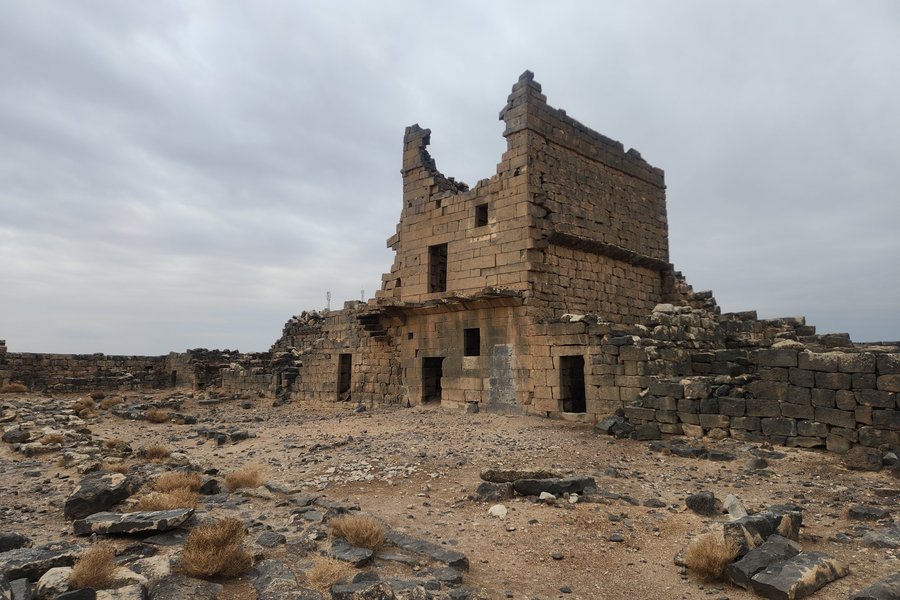
I visited Umm Al-Jimāl during my trip to Jordan and Egypt in the winter of 2025. Since I decided not to rent a car in Jordan, I had to find an alternative solution to reach the sites on the outskirts of Amman. So I hired a driver from the Black Iris Hotel in Madaba. Recommended by Lonely Planet, it was the place where I got the best price, and I can confirm that the service was excellent. We therefore left Madaba early and my driver took me to Qasr Kharana, Qusayr 'Amra, Azraq Wetland Reserve, Qasr al-Azraq, and Umm Al-Jimāl, before finally dropping me off in Amman.
The archaeological sites in Jordan are generally very well laid out and very easy to visit. Umm Al-Jimāl is no exception. The receptionists looked at my Jordan Pass (although entry is free) and then handed me a magnificent map of the site detailing some thirty points of interest and an itinerary to follow (available in this reference). I began my visit in the small museum. It explains the history of the site and displays a few artifacts in reconstructed traditional houses. Umm Al-Jimāl is not a grandiose site having been of capital importance in the region's history. The monuments are not stunning. However, it is a provincial town with traditional black basalt stone architecture whose ruins have survived the passage of time well.
The best thing about Umm Al-Jimāl is that you can walk around it like an archaeologist. Fascinating details …
Keep reading 0 comments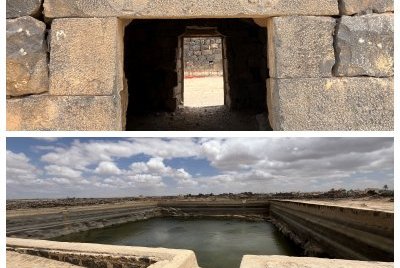
Despite its relative obscurity, Umm Al-Jimāl has been praised as “an archaeologist’s dream”. It’s not hard to take pictures here that would make it look like a Roman-Byzantine site, and the even earlier Nabataeans passed here too, but 90% of the site consists of vernacular architecture based on locally available and finely cut basalt stones. The site museum glorifies the “indigenous people [probably Arab nomads who settled down].. who continued their traditions and were no puppets of the various rulers”; the OUV is also solely based on the rural lifestyle of these Hauranian people. At the time, around 500-800 AD, Umm Al-Jimāl was a prosperous town based on agriculture and serving the next major city of Bosra (nowadays 80km away by car since you have to find a border post into Syria, but as the crow flies or the camel walks it is only 25km).
The archaeological site still requires no entrance fee and can be entered both via the south (where a friendly tourist police station is) and the northwest (adjacent to the central street of the modern town). The south is the main entrance, and the first stop here is the small site museum. It occupies a restored house typical for the area, built with sturdy black basalt stones to withstand the heat and with the horse stables inside. In the museum collection, the multilingual inscriptions stand out, such as the Dushara inscription on a cult stone with text in both Greek and Nabataean.
The …
Keep reading 0 comments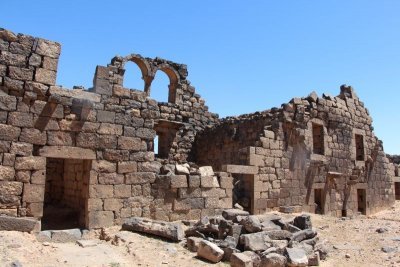
I visited Umm al-Jimal by rental car from Amman on a trip in May 2019, that covered the northern WHS of Jordan. Access was easy, even though it is close to the Syrian boarder and neighboured by a Military Air Base and a huge refugee camp.Even though not as spectacular as nearby Jerash, the place has its charm. There is so much left from the Byzantine/Umayyad city, that it rather looks like a town recently destroyed by an earthquake than an archaeological site from the 6th century. On the other side I had a hard time finding something from the Nabatean and Roman periods. The real beauty of the city lies in the building material. The region was formed by volcanic activity and everything was built with local black basalt stones. The site can easily be combined with Quasir Amra, As-Salt and even a few TWHS. There is not a lot of traffic outside of Amman, so a lot can be achieved during a productive day.
Keep reading 0 comments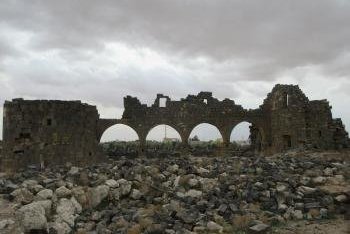
Umm el-Jimal are the ruins of Nabataean, Roman and early Byzantine town from the beginning of our era. It is located in one hour driving distance from one of the biggest Jordanian tourist attractions – Jerash. Although Syrian border is only 10 km away, access to the site is not limited or especially checked (which is the case of Umm Qays, another TWHS close to the Syrian border, where everybody has to be checked on the military checkpoint).
Although Jordan is famous from its ruined towns, Umm el-Jimal is probably the biggest of them. It is really huge and if you want to see all of it, reserve at least two or three hours. It is literally the sea of ruins of former streets, houses and churches. Some of the buildings remained less destroyed and now attract the biggest attention - one of the most impressive views is the lonely arch facade of former West Church. I suspect that Jordanian government wants to reconstruct some of the buildings before attempting inscription as a WHS (aimed for 2020), as I saw a crane on the site.
Based on what I saw, Umm el-Jimal was an interesting site worth visiting. Comparing to already inscribed ruined town of Umm ar-Rasas, Umm el-Jimal is even more interesting (although without so impressive mosaics), so I would be happy to see the place as a WHS.
Keep reading 0 comments
